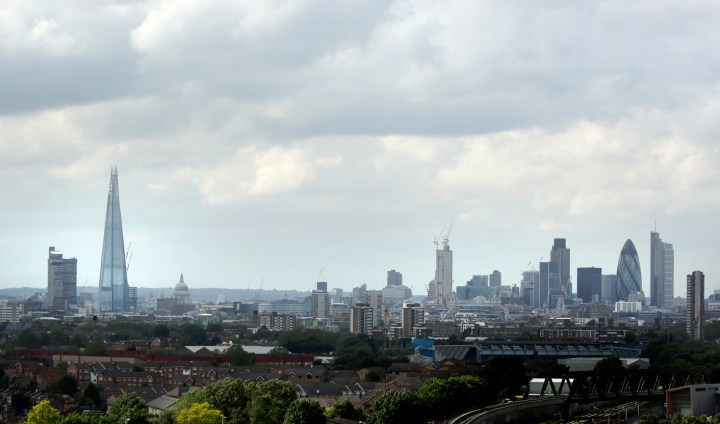Newsdeck
London Shard looms over Britain’s eclectic capital

Rising like a gleaming splinter of glass into a grey sky, London's tallest building is designed to mirror a dynamic city living ahead of its time. But for Londoners dwelling in its shadow, the futuristic new skyscraper known as the Shard is more a reflection of their own unease at the city's fast-changing and confusing identity. By Maria Golovnina.
Still an empty shell and yet to secure any office tenants, the giant Qatari-funded spire, the highest in western Europe, also stands as a powerful symbol of tough and unpredictable economic times.
Towering 310 metres (1,016 feet) over the south bank of the River Thames, the Shard already dominates London like no other building, its spire sometimes obscured by cloud in the British capital’s often overcast skies.
The 95-storey Shard, so called because of its resemblance to a gigantic glass splinter, has yet to be finished but this week marks the completion of its physical exterior. A delegation of Qatar royals has flown in to oversee the coming of age of their 1.5 billion pound creation.
London’s skyscrapers are modest compared with those of other financial centres in the Americas, Middle East and Asia. Even the Shard remains lower than New York’s Empire State Building, completed more than 80 years ago, and it falls well short of half the height of the Burj Khalifa tower in Dubai.
Moscow’s Federation Tower, like the Shard not yet finished, will be the highest in Europe at 360 metres.
But once completed next year, the Shard will boast some of Europe’s highest and most expensive flats, their bedrooms and kitchens offering views over a skyline where facades of bygone eras sit alongside the steel and chrome of a new London.
The squalor and extreme poverty of Victorian London, described by novelist Charles Dickens 150 years ago, are long gone. Yet the Shard stands close to some of the city’s most deprived areas where unemployment and crime remain rife as Britain endures its second recession of the financial crisis.
For some Londoners, its hulking mass next to London Bridge railway station is intimidating, with many scoffing at its flashiness as an example of wasteful spending at a time of economic and social uncertainty.
“There is nothing for local people in it. Some of the apartments at the top are going to sell for millions of pounds in an area where there is a lot of poverty,” said Lee, an office worker in her fifties who lives near the Shard.
“I can see it from everywhere. The best time is when it’s raining and the mist goes right all the way up and covers it, and you can’t see it. That’s the best time.”
Rouhman Choudhury, who helps to run local council housing estates, agreed. “It’s just monstrous,” he said, pointing at the Shard’s silhouette looming over a collection of rundown buildings.
“There are similar situations in other parts of London too where you have council estates with poverty and high unemployment. This doesn’t seem to help the community in any way. We don’t even know what’s inside.”
British media have given it a chilly welcome, with some calling it an example of the new “oligarchitecture” dominating London. Others see it simply an as eyesore, saying it has ruined views over the mediaeval Tower of London and Baroque St Paul’s Cathedral which once dominated the skyline.
“The skyscraper both encapsulates and extends the ways in which London is becoming more unequal and dangerously dependent on hot money,” the left-leaning Guardian daily wrote on June 25.
“So, the Shard: it’s expensive. It’s off-limits. It’s largely owned by people who don’t live here. And it is the perfect metaphor for what our capital is becoming.”
EMPTY SHELL
Designed by Italian Renzo Piano, the Shard is expected to draw rich customers from all over the world but so far it has signed only one pre-let deal with the five-star Shangri-La Hotel and spa.
Insiders shrug off concerns about finding tenants during the recession. ” They are in talks. But nothing has been signed yet,” said a person with knowledge of negotiations. “On tenants you will start hearing any time now, onwards.”
Liz Peace, chief executive of the British Property Federation, said the political and economic uncertainty arising from the Arab Spring and the euro zone crisis had driven up foreign interest in investing in prime London property.
“Everybody with money to spend wants to be in London … If you’re a sovereign wealth fund with lots of gas money, you can afford not to require a return next year or the year after,” she said. “People either love it or hate it, but I don’t see why you shouldn’t have iconic skyscrapers in London just because we have lots of lower-rise historic buildings.”
Curiously, a January report by Barclays Capital pointed to a correlation between new skyscrapers and hard financial times, saying construction of the Empire State Building and some other landmarks coincided with economic crises.
But some people are more positive. Ken Shuttleworth, an architect and mastermind behind another striking London skyscraper known as the Gherkin, said that the British capital, like any other city, had to evolve. “It’s not a museum, it’s basically a living, working organism,” he said.
Shuttleworth drew comparisons between London and the French capital where almost all skyscrapers stand outside the historic centre, including the Defense financial district.
“You can’t say it’s got to be like it used be in mediaeval times because that’s not feasible. Otherwise you end up with Paris, where nothing really happens in middle of Paris and everyone has to go and work out in La Defense,” he said.
But what would Dickens say? “I think he would be astonished. Absolutely astonished,” said Shuttleworth. “I’m sure if he was here, he’d write a book about the Shard.” DM
Photo: The Shard skyscraper and Saint Paul’s Cathedral are seen in a view of the London skyline from south London June 16, 2012. The Shark skyscraper, a 95-storey Renzo Piano-designed glass tower, with views across London’s financial district and the landmark St Paul’s Cathedral, is due to be completed in 2012 and will be the tallest tower in western Europe. Picture taken June 16, 2012. REUTERS/Kevin Coombs


















 Become an Insider
Become an Insider